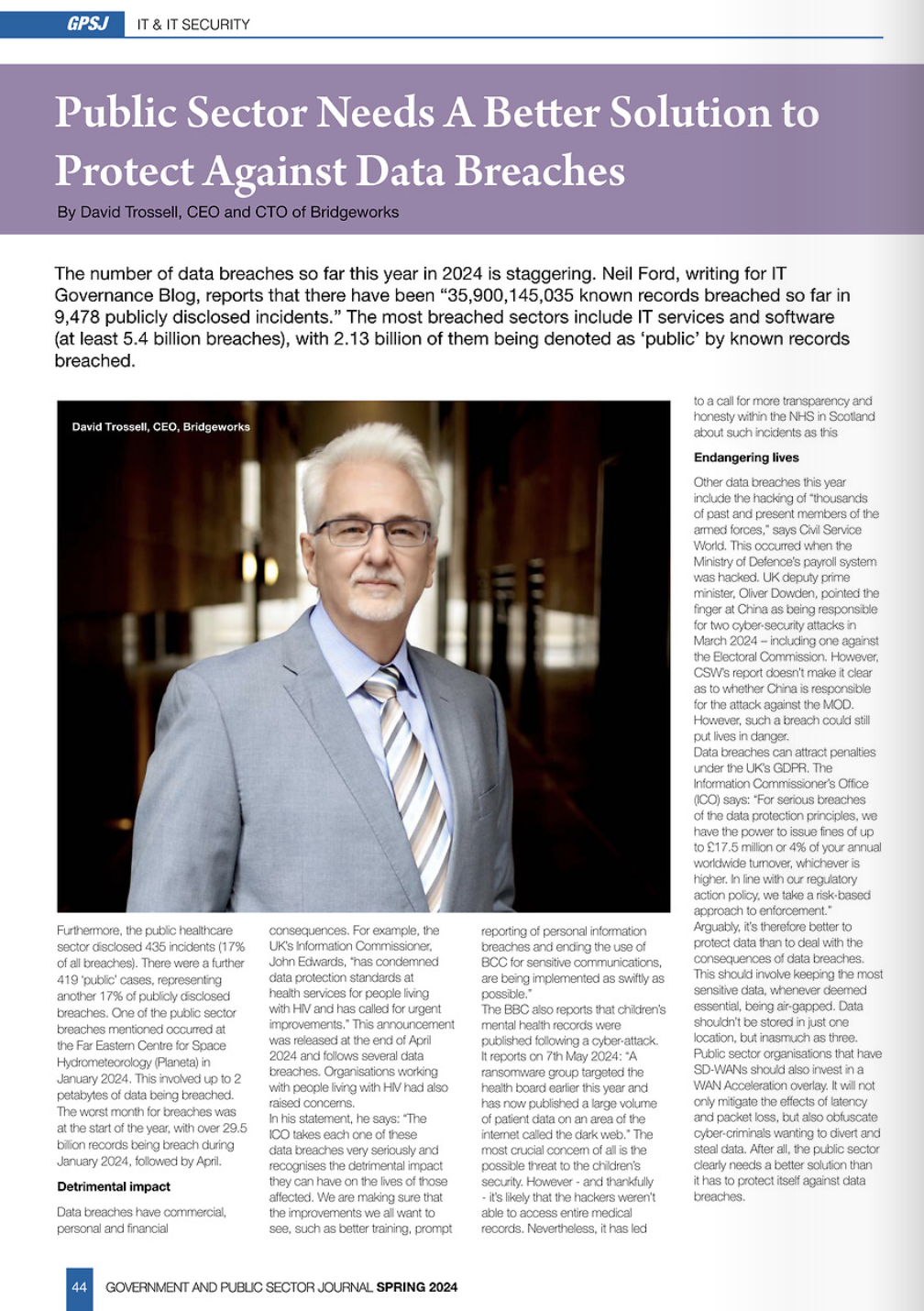David Trossell, CEO for Bridgeworks speaks with CloudTech News about the need for WAN acceleration, even when using SD-WANs.
![]()
September 28, 2020
Before the COVID-19 pandemic and lockdown struck, the predictions for software-defined wide area networks (SD-WANs) were glowingly positive. A Cato Networks IT survey forecasted strong growth for the technology, as buyers want to replace their multiprotocol label switching (MPLS) with a nimbler and more affordable alternative. However, the survey finds a need to consider the demands of digital transformation, and arguably now the changes in working practices, to avoid undermining confidence in SD-WANs.
The key findings of the WAN report, ‘2020 Networking Survey: How Digital Transformation Undermines Confidence in Enterprise Networks’, which Computer Weekly says surveyed 1,333 IT professionals across the globe, examining 2020 budgets, challenges and digital transformation readiness of today’s enterprises, also includes the need to consider the applicability of SD-WANs in relation to the broader need of the digital business whenever digital transformation is undertaken. This may include cloud migration, network agility, global reach, and the demands of a mobile workforce.
Oddly, organisations’ network confidence dropped post-digital transformation because they have often neglected to consider the implications of digital transformation during the process of selecting their SD-WANs. AS a result of this issue, 74% of the respondents said they felt less confident in their networks than before they pursued digital transformation. Interestingly, 60% of them also felt less confident with their cloud connectivity after completing their digital transformation, and it was also found that SD-WANs don’t add much to security. In fact, 66% of the respondents find themselves defending their organisations in 2020 against malware and ransomware, and only 37% of them believe that SD-WANs help to protect them.
Shifts in technology
In response to these findings, Phil Hill, solutions sales engineer at Bridgeworks comments: “As each shift in technology brings its own security challenges, SD-WAN was never going to offer anything to make the CISO (Chief Information Security Officer) position redundant.”
“In order to bring together lots of networking solutions to offer reduced costs, automated orchestration and reduced time to market changes the security perimeter which, is changing at a time which coincides with increased data residency and privacy issues/ requirements. Whilst SASE might be able to address the arduous task of stitching together the transformed solutions with their users, the location and compliance concerns, may still need to be many checked.”
He adds that there are some techniques that some vendors use “to optimise WAN traffic will prove less effective once they then need to encrypt more of their data, once the CISO’s been through the design.”
SD-WAN: Cost motive
Joe O’Halloran, in his ComputerWeekly article about the report, ‘Digital transformation shaking confidence in SD-WAN’, notes: “Most respondents (56%) consider SD-WAN as a way to reduce WAN costs, and network agility as it applies to sites – whether in the form of faster site deployment or increasing bandwidth – was also a popular outcome. Cloud applications are now key to the enterprise but not native to SD-WAN. Most respondents (60%) said cloud applications would be the most critical to their organisations over the next 12 months, even more critical than applications hosted in their private datacentres. Yet SD-WAN solutions require additional software and integration to support the cloud.”
“Only enterprises with SASE architectures showed increased network confidence following digital transformation. Most respondents (62%) with a SASE architecture were more confident about their networks after digital transformation. By contrast, only 26% of SD-WAN respondents were more confident in their networks. Cato said this was likely to stem from the close alignment of SASE’s capabilities with digital transformation requirements. The market segment converges networking and security into a global, cloud-native service that uses SD-WAN to connect sites, client/clientless access for mobile users and native cloud integration to support cloud resources.”
SD-WAN take-up
Despite the reported knocks in confidence, David Trossell, CEO and CTO of WAN acceleration provider Bridgeworks, says he’s not seen it. “Our customers are taking up the technology. Don’t get me wrong, SD-WANs are not perfect, and the technology still has a few issues on performance over distances and at the higher bandwidths,” he says.
“However, SD-WANs are such a powerful pervasive technology, so why wouldn’t you implement it? Yes, we are still developing the technology, but this shouldn’t affect the digital transformation process”.
Instead of being detrimental to the digital transformation process, he thinks it should enhance it. Nevertheless, he finds that – as with many forms of transformation, not all the parties involved in the process are “fully immersed in the project and understand the implication of such actions.”
SD-WAN performance
He cites an example from the Cato Networks’ report: “When asked if respondents can provide access to cloud-based resources with the performance and availability comparable to internally hosted resources, respondents from all networks – MPLS, hybrid WAN and SD-WAN showed a significant drop off post-digital transformation.”
To Trossell, this drop off in performance is obvious and it would be to any experienced networking engineer. He explains that latency within the datacentre is sub-millisecond: “When you move these resources to the cloud you are going to experience latency in the 5-15ms or more, which has a dramatic effect on performance. This is lining up the reader ready for a pitch for their product further into the report.”
COVID-19: Remote working
So, has the COVID-19 pandemic, which many commentators now believe is endemic, changed SD-WAN trends and confidence in the technology? Well, it did shut down what Trossell describes as our ‘normal offices’, pushing people who weren’t accustomed to working from home to do so. For some people this has been a struggle, particularly with the need to also home-school their children, and yet many people have seen benefits of working from home. With it looking like the world will have another lockdown, I think home-working is here to stay for some considerable time.
Nevertheless, he believes that remote working of this kind is “a perfect application for SD-WAN with its abilities to define security, access, and route traffic through the data centre and then onto cloud applications, whilst still maintaining secure connections to corporate facilities and apps.”
WAN Acceleration
Although SD-WAN is not seen by Trossell as losing confidence, he says WAN Acceleration is not a substitute for it. In fact, SD-WANs can be enhanced with WAN Acceleration Overlay: “You can run WAN Acceleration over SD-WAN or on its own to improve the performance over distances outside of the data centre, such as the cloud of other offices located at large distances.”
WAN Acceleration can therefore enhance the performance of SD-WANs as a complementary solution to mitigate issues such as latency and packet loss – therefore improving WAN performance, and potentially confidence in SD-WANs, while enabling digital transformation. He explains: “If properly implemented, there should be no reason to doubt SD-WAN. In fact, with the new features and Machine Learning that Palo Alto has just announced it looks very exciting; and as I have said, WAN Acceleration can redress some of the concerns about performance when going outside of the data centre.”
Improving digital transformation
Trossell therefore offers his top 5 tips for improving digital transformation: The first piece of advice he offers is to get all the stakeholders together: ”While everyone soon will be in lockdown working from home, I would forget the Big Bang implementation. Instead, roll out the one with minimal impact and then settle it down before implementing the next phase. Always, always have a backout plan and if possible, and test it!”
There is then the need to complete a worst-case scenario assessment to understand the impact before rolling it out. With networking, cloud and digital transformation plans carefully. Don’t forget the user, especially if they are working from home, asking your colleague next to you for help is a bit more difficult.
He concludes that the next steps for SD-WANs include the launch of intelligent SD-WAN products with machine learning to reduce the burden on network administration. So, should shaken confidence in SD-WANs lead to WAN Acceleration? Yes, but the latter as explained by Trossell doesn’t supersede the other. They can complement each other, and SD-WANs are much enhanced with an WAN Acceleration overlay.
Click here to read the full article on Cloud Tech News.




